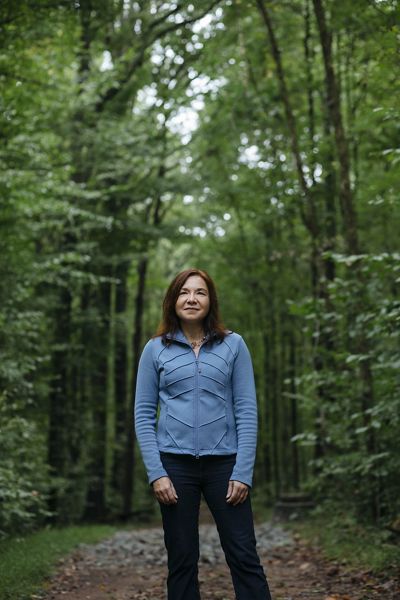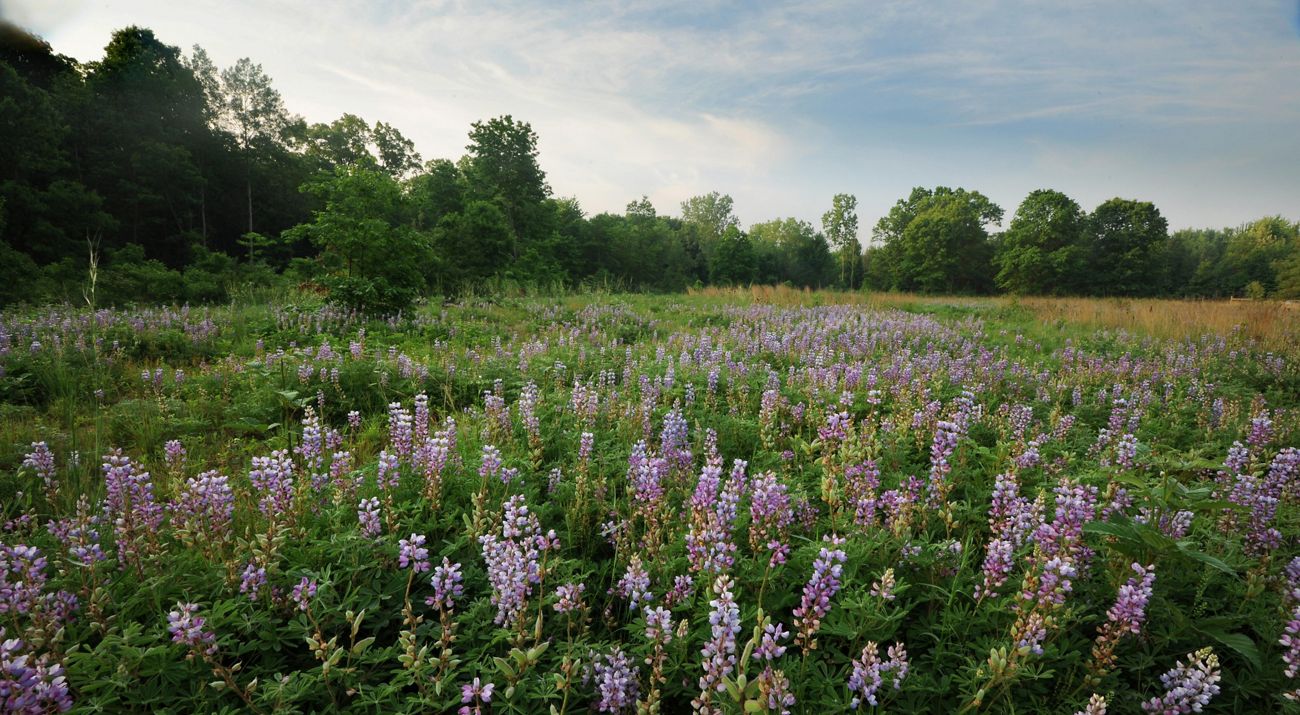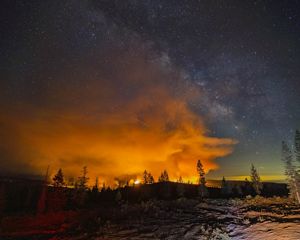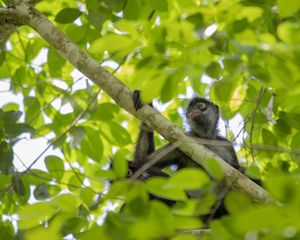A Climate for All of Us
The Nature Conservancy’s new chief scientist, Katharine Hayhoe, shares why she cares about climate change and her fears about who will be hit hardest.
Winter 2021
As a child, I learned to explore the world around me with my science teacher dad. He taught me things that fascinated me, like how rocks form, why trees communicate with each other and what the sun is made of.
My fascination with the universe led me to study astrophysics in university. By my second year, I was operating the telescope on the roof of the science building, tracking variable stars. By my third year, I was analyzing images of galaxy clusters captured by the 3.6-meter Canada-France-Hawaii telescope and scouting out potential graduate schools that would allow me to continue this work. But that same year, a class I happened to take on the science of climate change altered the course of my life.
I knew climate change was real, but I considered it to be an “environmental” problem of the future. What I learned in that class shocked me. Climate change was no longer a distant issue. Already, in the 1990s, its impacts were evident around the world, and the need for action was urgent. Even worse, I learned that climate change disproportionately impacts the marginalized, poor and vulnerable—those who have done the least to contribute to the problem.
Given the urgent need for action and the injustice of climate impacts, I thought, how could I not step up to help? That’s when I decided to become a climate scientist.
Emissions Inequality: The majority of carbon emissions between 1990 and 2015 were generated by the wealthiest people around the world. A single seat on a long-haul airline flight, for example, generates more CO2 than the average citizen’s annual carbon output in dozens of countries.
Vulnerable People: Research shows that the poor—those least responsible for contributing to global carbon emissions—are the most vulnerable to the growing impacts of disasters exacerbated by climate change, such as heat waves, floods, storms and wildfires.
The Science is Clear
Throughout the history of human civilization, the average temperature of the Earth has varied by no more than a few tenths of a degree. We’ve taken this stability for granted.
Today, however, that assumption no longer stands. The Earth is now running a fever, with global temperature rising faster than any time in human history. Scientists agree: This global temperature increase is entirely human caused.
Since the dawn of the Industrial Revolution, humans have been burning more and more coal, gas and oil. Those emissions are responsible for 75% of our climate problem. We’ve also been deforesting large swaths of the planet and raising vast herds of methane-belching livestock, and that’s the source of the other 25% of our massive emissions of carbon dioxide and methane, powerful heat-trapping gases. As they have built up in the atmosphere, they have essentially wrapped an extra blanket around the planet, causing it to warm.
Carbon dioxide levels in the atmosphere are now 50% higher than in pre-industrial times, and methane levels have more than doubled. Altogether, human emissions have already increased the average temperature of the planet by about 1.1 degrees Celsius (2 degrees F), and that rise is accelerating. It’s estimated to hit 1.5 degrees Celsius (2.7 degrees F) over the next two decades, according to the U.N. Intergovernmental Panel on Climate Change’s 2021 report—even with ongoing efforts to reduce carbon emissions and deploy nature-based solutions.
Quote: Katharine Hayhoe
Our power multiplies exponentially when we advocate for climate solutions.
It’s Global Weirding
Global warming—an increase in the average temperature of the planet—isn’t something we notice directly in our daily lives. What we do notice, though, is global weirding.
Simply put, climate change is loading the extreme weather dice against us. We always have had a chance of rolling a double six—a record-breaking hurricane, heat wave, flood or the like. But over time, climate change has been switching out some of the numbers on our dice to increase the odds that we role those double sixes.
Climate change is the reason why unprecedented heat waves are baking the Pacific Northwest and thawing permafrost in the Arctic and Siberia. It’s also why heavy precipitation events are increasing in frequency and severity, dumping record-setting levels of rainfall from Texas to Germany. As the oceans warm, tropical storms like hurricanes, cyclones and typhoons are becoming stronger and intensifying faster, wreaking greater havoc around the world. Rising sea levels are inundating low-lying coastal areas from Bangladesh to the South Pacific to Miami. Longer, stronger droughts are ravaging East Africa and much of the western United States, and more intense wildfires are burning greater areas in places like Australia, British Columbia and California.
These extreme events, amplified by climate change, affect our food production, our water quality and supply, the safety of our homes and even our health. That’s why climate change is a global threat, perhaps the greatest we have ever faced as a species. No matter where we live or what we care about, we are all vulnerable to the devastating impacts of a warming planet.
People Are at Risk
Climate change doesn’t affect all of us equally, though. No matter where we live, it’s the poor and marginalized who are most vulnerable to extreme weather events, even though they’ve contributed least to the problem. From 1990 to 2015, for example, it’s estimated that the richest 1% of the world produced 15% of global emissions—that’s twice as many emissions as the poorest 50% produced over that period.
What’s more, people with the fewest resources—migrants, refugees and residents of low-income communities—are suffering the greatest consequences. The World Bank estimates that by 2030, climate change could force an additional 132 million people into extreme poverty, living on less than $1.90 a day. This makes climate change not only a scientific, an environmental and a human issue, it makes it an urgent moral one.
Who are those most affected by climate change? They include subsistence farmers in low-income countries, who watch as droughts wither their crops and dry up their wells. Or some Indigenous peoples fighting to maintain their traditional livelihoods as once-stable ecosystems shift around them. Or the homeless, outdoor laborers and anyone who lives without air conditioning in hot climates subject to heat waves. The list includes many others.
In the United States, climate change is unavoidably an issue of socioeconomic and racial justice. Diverse coastal communities in the South are disproportionately at risk from rising sea levels, stronger hurricanes and flooding. Across the country, neighborhoods shaped by the legacy of “redlining”—a racist 20th-century federal housing policy that made it impossible for minority communities to get access to loans, mortgages or even insurance—can be up to 20 degrees Fahrenheit hotter in the summer than richer areas in the same city (see “Shade Shortage,” page 12). That’s because these areas have fewer trees and more concrete, which in turn means higher air-conditioning bills and more heat stress for the people who live there. Once again, those who have done the least to contribute to the problem are bearing the brunt of its impacts.

Together We Can Tackle Climate Change
Here’s the good news. Just as climate impacts disproportionately fall on those who have the least, many climate solutions benefit those very communities. These include efforts to develop clean energy, to restore ecosystems and to build climate resilience and adaptation in urban centers.
The transition to clean energy is already underway. More than 90% of new electricity sources installed around the world in 2020 were clean energy, including solar and wind power. Even in Texas, where I live, the heartland of the U.S. oil and gas industry, 23% of electricity in 2020 came from wind energy—more than any other state.
Ecosystem management also has an important role to play. Arctic peatlands are incredibly rich in carbon: It’s estimated they contain four times more carbon than humans have emitted since the beginning of the Industrial Revolution. Conserving and protecting Arctic land keeps that carbon in the ground and allows the land to draw down and store even more carbon. In the Northwest Territories of my home country of Canada, TNC’s Canadian affiliate, Nature United, helped the Łutsël K’é Dene First Nation conserve and assert their ownership over 6.5 million acres. This area, called Thaidene Nëné, stores 379 million tons of carbon—equivalent to half a years’ worth of Canada’s national emissions.
In the U.S., the Green Heart Project has been building climate resilience in Louisville, Kentucky, since 2017. A partnership between TNC and local organizations, it’s the first controlled experiment to test the health effects of tree cover, which reduces temperatures and filters pollution, in urban neighborhoods. The presence of trees has been shown to reduce stress, obesity and rates of asthma and cardiac disease. The project, which has planted thousands of urban trees, monitors improvements in residents’ health as their neighborhoods become increasingly green.
Our Way Forward
To ensure healthy people and a healthy planet we must:
- Cut our carbon emissions as much as possible and as soon as possible
- Build resilience to the impacts we can no longer avoid
- Conserve the lands and waters on which all life depends.
These are TNC’s goals, and they’re mine, too.
But you might be thinking: Where do I come in? What more can I do to help? You can do a lot. In fact, you are vital to accomplishing these goals; all of us are. Our small personal actions—reducing our food waste and energy consumption, trying more veggie recipes, switching to clean energy—send a market signal. Talking about your goals can inspire others to start making changes by altering our social norms. And our power multiplies exponentially when we advocate for climate solutions in our place of work or worship, our school, or our city or state.
The world has changed before, and usually not because world leaders sat down and decided it had to. It’s changed because ordinary people pushed for change. U.K. researcher Finlay Green compares the challenge we face of halting climate change to the challenges facing huge social movements of the past, such as ending slavery. Yet by being "small cogs in a very large machine,” he says, “they were able to make a difference.”
And how did it happen? When people—like you and me, and Green and my science teacher dad, and all the people who care about the injustices—rallied together to call for change. That’s why, as I share in my new book, Saving Us, I’m convinced that the most important thing every one of us can do is this: Use your voice to share why climate change matters, and how action benefits us all.





